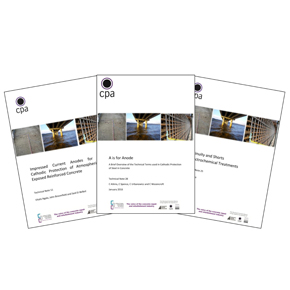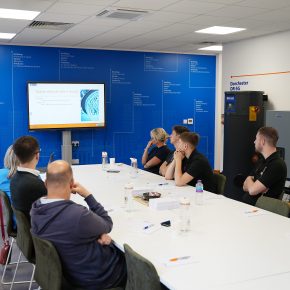
CPA publish new guide on cathodic protection and electrochemical treatments
The Corrosion Prevention Association (CPA), part of the Structural Concrete Alliance, has published a number of guides to help users understand available cathodic protection (CP) and electrochemical treatments for structures.
Technical Note 11: Impressed Current Anodes for the Cathodic Protection of Atmospherically Exposed Reinforced Concrete provides a summary of the anode systems commercially available in the UK. Aimed at specifiers and asset managers with overall responsibility for structures, the document details the main features of each system including installation, application and performance.
Current cathodic protection is used primarily to provide corrosion control on reinforced concrete structures suffering from reinforcement corrosion and is also applied to 20th century steel framed masonry and brick clad buildings and monuments.
The document categorises the anode systems into six main types: conductive organic coatings; thermal sprayed zinc; coated titanium expanded mesh/mesh ribbon in a concrete overlay; coated titanium expanded mesh ribbon – mortared into slots chased into the concrete or embedded in new construction; internal conductive ceramic titania or coated titanium (discrete) anodes; and conductive cementitious overlay containing nickel coated carbon fibres.
Technical Note 11 stresses that anode specification should be made by a qualified Cathodic Protection Engineer, with a Level 3 certification to BS EN 15257 in cathodic protection of steel in concrete.
The CPA has also published a glossary of technical terms used in cathodic protection of steel in concrete, Technical Note 28: A is for Anode, in addition to new guidance on the impact of continutity and and shorts on the efficiency and continued performance of such a systems, titled Technical Note 25: Continuity and Shorts in Electrochemical Treatments.
The document explains the effect of shorts and steel discontinuity on electrochemical treatments, including mpressed current and galvanic cathodic protection, chloride extraction, re-alkalisation, and hybrid treatments using a temporary power supply.
Corrosion Testing of Concrete Structures
The CPA has also published Technical Note 27: Corrosion Testing of Concrete Structures to explain how to assess corrosion risk and make informed decisions about repair strategy based upon a broad base of information.
Corrosion is commonly caused by a number of variables: changes in the concrete permeability, caused by local differences in composition, compaction and curing; construction errors leading to areas with low concrete cover to reinforcement; and variation in the exposure environment, leading to areas with elevated chloride ion content or high carbonation depth.
Technical Note 27 states that corrosion testing should help to develop an understanding of the exposure variability, ascertain risk and help prepare a repair and maintenance strategy. It also explains that delamination and visual surveys are the most common methods used for ascertaining risk – but these alone cannot determine corrosion risk over the entire structure.
The findings of these surveys should be used to select or target representative locations for further testing, such as closer grid half cell potential surveys; screening for chloride and other contamination; testing for depths of carbonation; corrosion rate monitoring; or concrete resistivity testing.
Visit the Structural Concrete Alliance website
Visit Supplier's page
Latest news

25th April 2024
BMBI: Value sales in first two months were -3.4% down
The latest Builders Merchant Building Index (BMBI) report shows builders’ merchants’ value sales were down -4.7% in February compared to the same month a year ago.
Posted in Articles, Bathrooms & Toilets, Bathrooms, Bedrooms & Washrooms, Bricks & Blocks, Building Associations & Institutes, Building Industry News, Building Products & Structures, Building Services, Civil Engineering, Concrete, Cement, Admixtures, Drainage, Floors, Hard Landscaping & Walkways, Interior Design & Construction, Interiors, Landscaping, news, Paints, Paints, Coatings & Finishes, Plant, Equipment and Hire, Plumbing, Posts, Publications, Research & Materials Testing, Restoration & Refurbishment, Retrofit & Renovation, Sustainability & Energy Efficiency
24th April 2024
The lowdown on Origin’s New Soho Offering
Origin’s Soho External Door is the first launch in its new generation of products, setting a higher standard for the fenestration industry.
Posted in Access Control & Door Entry Systems, Aluminium Products, Architectural Ironmongery, Articles, Building Industry News, Building Products & Structures, Building Systems, Doors, Innovations & New Products, Posts, Restoration & Refurbishment, Retrofit & Renovation, Security and Fire Protection
24th April 2024
Mitsubishi Electric welcomes new code of conduct for smart appliances
Mitsubishi Electric welcomes a new code of conduct on energy smart appliances which the European Union (EU) announced yesterday at the Hannover Fair in Germany.
Posted in Air Conditioning, Articles, Building Industry Events, Building Industry News, Building Products & Structures, Building Regulations & Accreditations, Building Services, Exhibitions and Conferences, Facility Management & Building Services, Heating Systems, Controls and Management, Heating, Ventilation and Air Conditioning - HVAC, Plumbing, Retrofit & Renovation, Seminars, Sustainability & Energy Efficiency
24th April 2024
Hamworthy Heating expands CIBSE approved CPD modules with new hot water series
Hamworthy Heating, technical experts in commercial heating and hot water products, announce the expansion of its market leading CIBSE approved Continuing Professional Development (CPD) portfolio with the launch of three new learning modules.
Posted in Articles, Building Industry Events, Building Industry News, Building Products & Structures, Building Services, Continuing Professional Development (CPD's), Facility Management & Building Services, Heating Systems, Controls and Management, Heating, Ventilation and Air Conditioning - HVAC, Plumbing, Retrofit & Renovation, Seminars, Training
 Sign up:
Sign up: